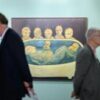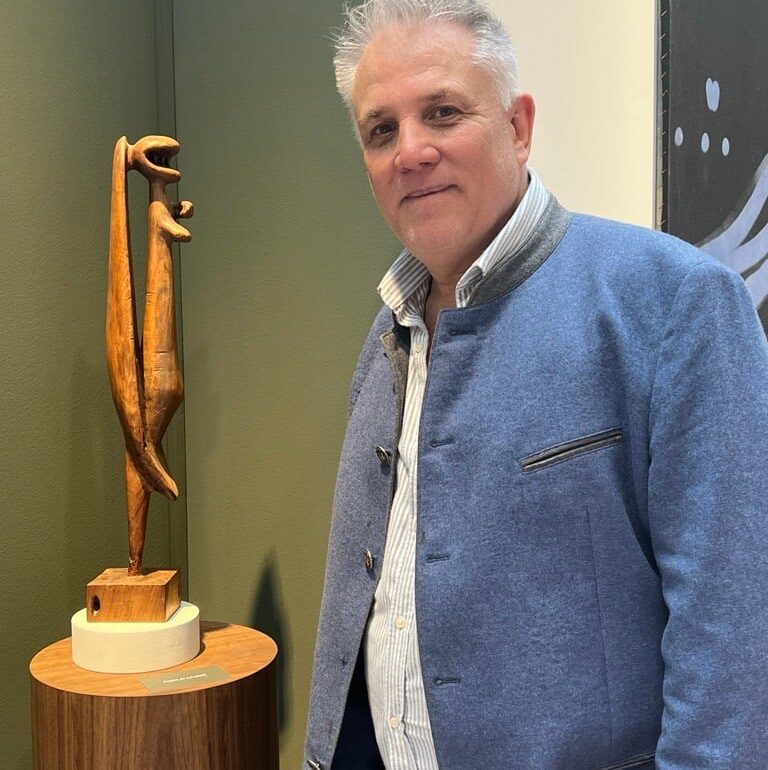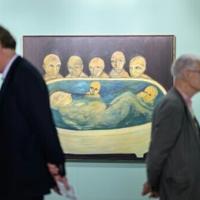The line of VIPs waiting to enter Art Basel Paris this morning stretched around the block, but Canadian collector Francois Odermatt avoided that 30-minute queue by entering through a side door.
Less than three hours later, having run around the fair’s 195 exhibitors, he was the proud owner of a 1955 wooden sculpture by the Cuban Surrealist Agustin Cárdenas (1927-2001). Offered by Di Donna Galleries, the 23-inch curvilinear piece had an asking price of $100,000.
You had to pay a lot more for works by hot contemporary artists, like Emma Webster ($165,000 at Perrotin), Avery Singer ($800,000 at Hauser and Wirth), and Victor Man (€1.2 million, about $1.3 million, at David Zwirner). All three sold on the first day, according to the galleries.
“I’d rather buy something that’s part of art history,” said Odermatt, who has taken a pause on acquiring emerging art and is finding better value by going “back to the roots.”
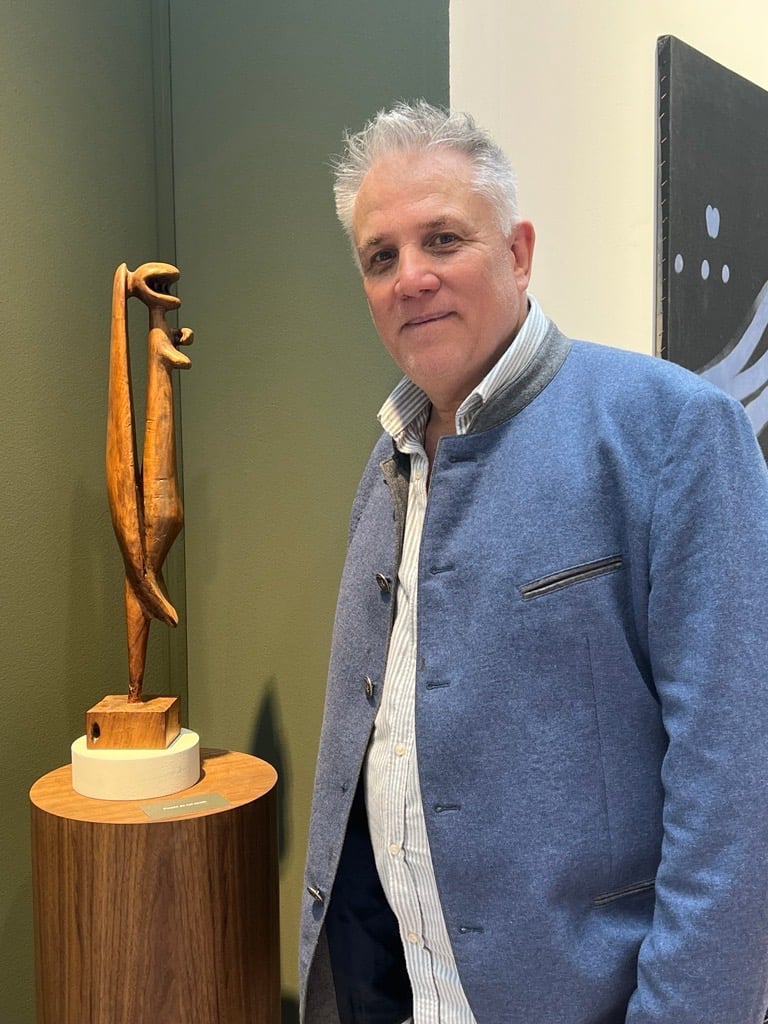
Collector Francois Odermatt with his newly acquired sculpture by Augustin Cardenás at Di Donna Galleries. Photo: Katya Kazakina
He was among the thousands of people who flocked to the first edition of the rebranded Art Basel Paris (née Paris+) at the Grand Palais, which is resplendent after a recent facelift. The space was heaving with people. Fashion designer Raf Simons, German soccer star Michael Ballack, Hollywood actor Owen Wilson, actress Natalie Portman, and New York billionaire Leon Black were all spotted on the ground.
Following a string of grim, chilly days, the sun came out and it felt like summer, albeit a summer framed by yellow and red foliage. Inside the 124-year-old landmark, which is famous for its vaulted glass roof, some visitors donned sunglasses and complained about not wearing sunscreen, as Artnet’s Kate Brown reported.
“Paris in the sunshine definitely dispels clouds over the art market,” said Tom Danziger, an art lawyer from New York. “At least for today.”
Dealers were covered in sweat as they worked to close sales. Many looked hot and exhausted, but said they were in a good mood, even as they acknowledged challenging market conditions. The fair organizers reported a litany of sales by the end of the day, led by White Cube, which moved a Julie Mehretu painting with an asking price of $9.5 million.
“It’s pretty good, considering two wars and the crazy election,” a terse Gavin Brown, a partner at Gladstone Gallery, said.
Gladstone quickly sold a disturbing portrait of a woman by Joseph Yaeger for £75,000 ($97,400), which is not a surprise, considering that another painting by the artist, Sphinx without a secret (2021), fetched £203,200 pounds ($265,239) at Phillips last week.

Joseph Yaeger’s painting at Gladstone’s booth at Art Basel Paris sold for £75,000 ($97,400). Photo: Katya Kazakina
“These fairs are about customer acquisition,” said Andrew Edlin, whose gallery in New York focuses on so-called outsider artists. “You get six to eight new clients. Over the years, you build a business this way. It’s like a force multiplier. There’s no better model to meet new clients.” (Edlin is the owner of New York’s Outsider Art Fair, which had a Paris edition between 2013 and 2022.)
But there was an excitement in the air that was about more than business. Perhaps it was a sense of history, amplified by the fair’s setting. The Grand Palais was built for the Universal Exposition of 1900, which premiered innovations like the Ferris wheel, trolleybuses, escalators, and electric fire engines.

Art Basel CEO Noah Horowitz. Photo: Katya Kazakina
“As a student of art history, you feel part of a lineage,” Noah Horowitz, Art Basel’s CEO, said. “Paris is the city that wrote the story of the avant-garde. And we are part of that narrative: Art Basel Paris reopening at the Grand Palais in 2024. It will be in history books.”
It was easy to be dazzled.
“This show, it’s like being in a museum,” said Barrie Somers, a U.S.-based art collector. “The works of art are unparalleled. The venue is spectacular beyond words.”
Dealers saved a lot of formidable material for the fair. Surrealism, which is the subject of at least two major exhibitions in Paris right now, took the front seat in a number of booths, with too many paintings by Joan Miró and René Magritte to count.
Nahmad Contemporary brought a large Max Ernst canvas, Cage, foret et soleil noir (1927), priced at $10 million. (It fetched £3.1 million at Christie’s in 2021). Tucked away at Pace was a tiny jewel of a painting by Ernst, Alice in 1939 (1939), depicting his lover and fellow artist Leonora Carrington in the middle of a strange metamorphosis, priced at $4.5 million. Emmanuel Di Donna sold several works from his museum-quality booth, which features four Surrealist artists—Cárdenas, Wifredo Lam, Yves Tanguy, and Alicia Penalba. The same quartet will be the focus of his next exhibition in New York, opening October 29.
“My market is fine,” he said. Acquiring “top-end 20th-century works at prices that make sense” is an “easy decision” for collectors to make.
The priciest work for sale at the fair was Suprematism, 18th construction, a 1915 painting by Kazimir Malevich, dramatically displayed against a royal-blue background at Hauser and Wirth. The painting fetched $33 million at Sotheby’s in 2015. And while the gallery declined to reveal its asking price, Carlo Knoell, the senior director who procured the consignment, said, “It’s not very different today.”
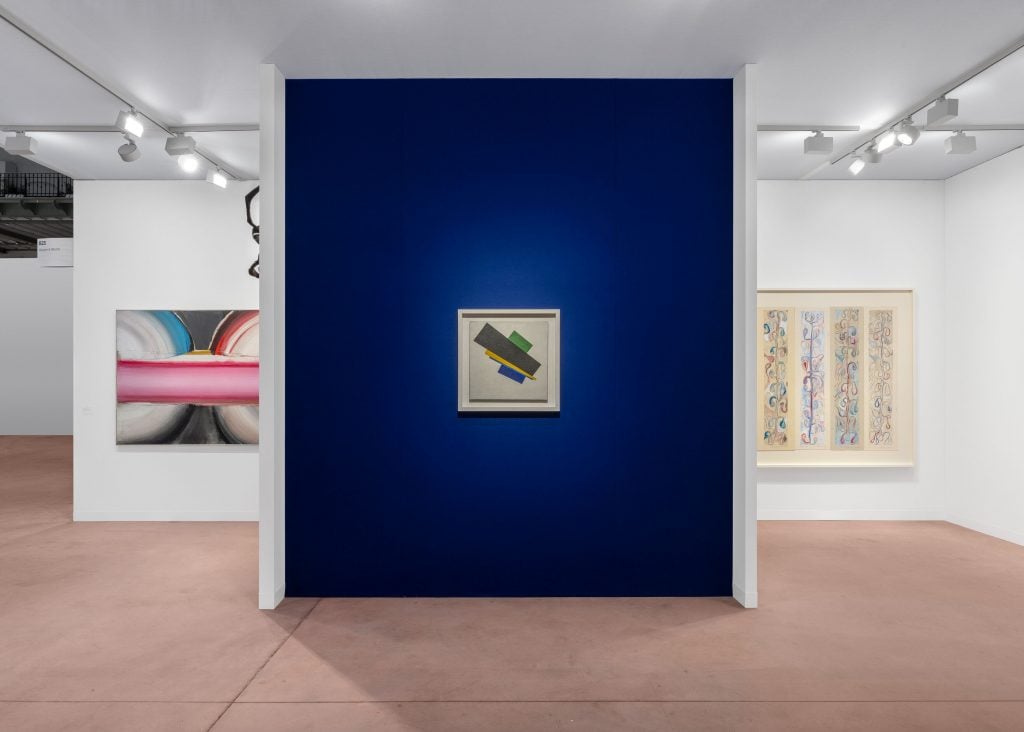
A view of Malevich’s painting at Hauser & Wirth, Art Basel Paris. Courtesy: Hauser & Wirth
Robert Landau, who is known to offer Impressionist and Modern artworks at eye-watering prices through his Landau Fine Art gallery, displayed Kandinsky’s Murnau mit Kirche II (1910), which fetched $44.8 million at Sotheby’s earlier this year. The gallery also showed it at Art Basel in Switzerland in June.
“It’s the most expensive painting in this building,” he said. “But it’s not for sale.”
Several leading galleries brought works by Gerhard Richter, whose secondary market has declined in recent years; none has yet been reported as sold. The top of the bunch is a big, red abstraction priced at $22 million at Vedovi Gallery, of Brussels. David Zwirner offered two photorealist paintings, at $8 million and $14 million, according to other dealers.
“This is the right time to get back into his market,” Paolo Vedovi said. “People realize that, instead of buying trendy contemporary art, they can buy historic works.”
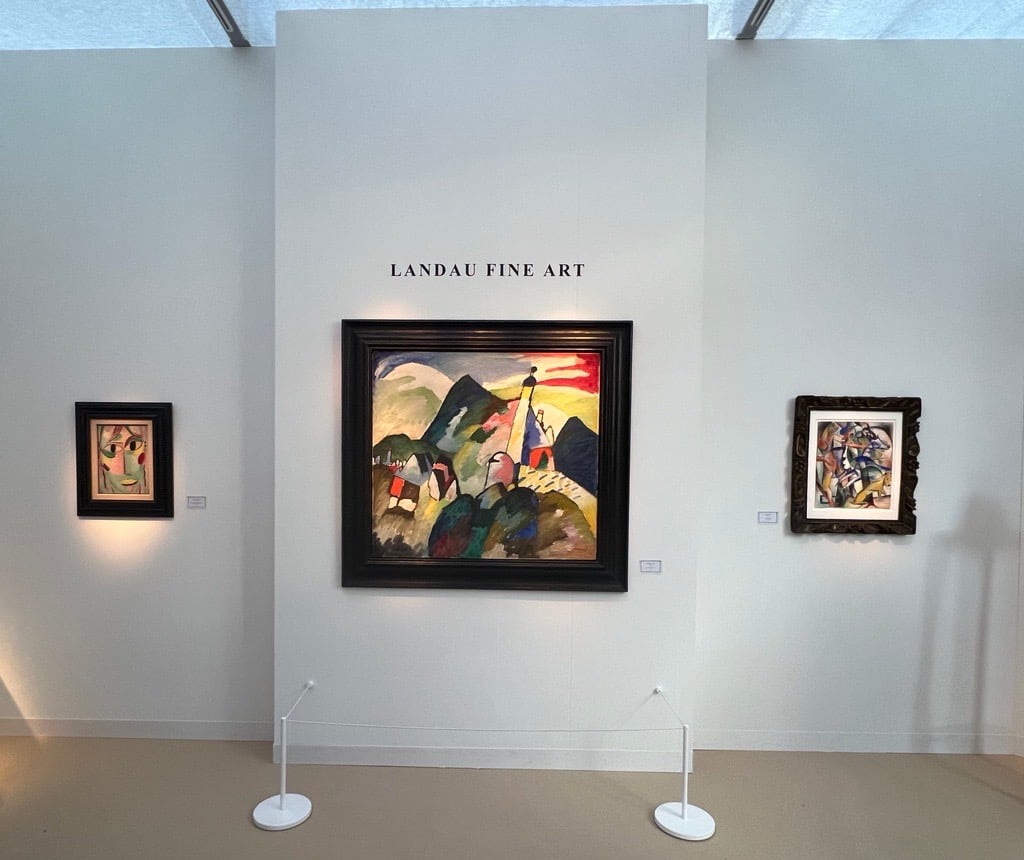
Landau Fine Art’s booth, where a not-for-sale Kandinsky is on view. Photo: Katya Kazakina
Pieces by Tom Wesselmann, an undervalued Pop artist who is the subject of a sprawling retrospective at the Fondation Louis Vuitton, were on display in many booths. “Maybe the show will change the market,” said Vedovi, who was offering one painting for $4.9 million.
Art Basel Paris runs through Sunday. In the coming days, collectors will decide whether to convert reserves into purchases, and dealers will mull offers and discounts. Then they will wait to be paid.
“By tomorrow, we should be able to say we’ve done a lot of business,” said New York dealer Christophe van de Weghe, whose opening-day display included a $22.5 million Jean-Michel Basquiat, several Picassos, and a big Wesselmann.
Even the most beautiful days have to come to an end. The sun was setting, and a rainstorm would soon erupt over Paris.
This post was originally published on this site be sure to check out more of their content

